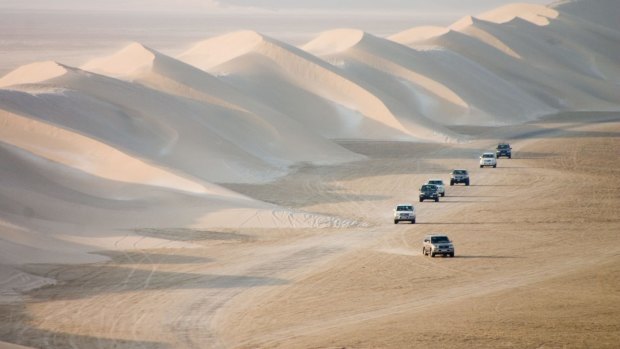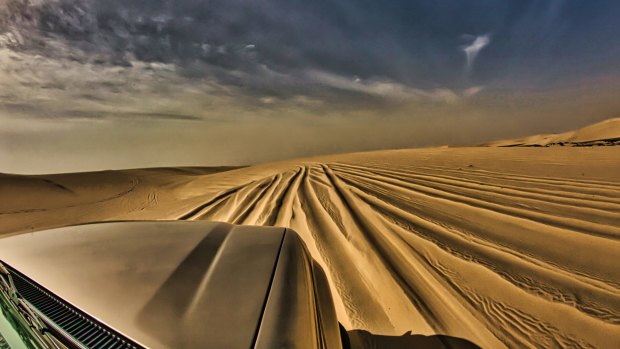This was published 1 year ago
Qatar dune safari: A wild ride where water is more expensive than petrol

Dune safaris can be intense.Credit: Alamy
You must drive fast in the desert and lay off the brakes, says guide Alam Khan as he turns from the road and speeds towards the dunes.
The desert ripples heavenwards and spreads out behind us in a sheet of ivory silk. The outskirts of Mesaieed - a petroleum city 40 kilometres south of Doha - are vapourised by plumes of grit. Trucks line up here to collect the mountains of sand blown in during desert storms; the sediment will be transported to the north of Qatar and used to backfill rocky beaches. An oil refinery hulks apocalyptically across the wasteland; during the pandemic it emptied of employees after fuel prices plummeted.
"Even now, petrol is cheaper than water in Qatar," Khan said. "A litre of water is four, five riyal. A litre of petrol? Two riyal."

Teetering on the edge of a dune before the descent.Credit: iStock
But there's good news for those employees: the cost of fuel is rising. The viscous resource has enriched the emirate far beyond measure; this parched, largely unoccupied nation is constructed improbably - and lavishly - on the proceeds of a commodity indispensable the world over. In Doha, skyscrapers spangle the skyline and the iridescent waters of the Persian Gulf lap a city humming with aircon and the accoutrements afforded by vast wealth. But you can't drink oil.
Khan changes gear and races full throttle towards the foot of a dune. Outside, the temperature simmers far above 40 degrees; rheumy light fills the empty space beside us. The wheels spin and grind and propel us into a near-vertical ascent. Centrifugal force pins my head to the headrest; I hadn't expected a desert safari to be so intense. How I long to be back at the camel drivers' settlement south of Mesaieed, where the road peters out and tar dissolves into desert. We'd stopped there to release air from the tyres and watch cameleers hawk rides on their rainbow-tasselled charges.
Now we're balancing on the lip of the dune. The desert stretches ahead in blinding, velvety undulations; it's fringed by a strip of sea. The car tips forward, teeters, and plummets into the abyss. Sand floods the windscreen; my heart thuds in the pit of my stomach; we come to rest on a salt pan, intact and uprighted. Khan pulls to the side so we can observe the descent of the car following behind us: it balances on the dune's razor-sharp summit, tilts momentarily and slides sideways to the desert floor, shovelling great draughts of sand as it goes. The spectacle seems to unfold in slow motion when viewed from this grounded perspective.
The dunes roll on towards Khawr al Udayd, the inland sea separating Qatar from Saudi Arabia. Up we climb, down we shimmy. We pass a group of tourists jumping in unison for a photo; heat and sand encircle them like smoke. It's the height of summer, the most foolhardy time for a desert incursion. But this desolate quarter is a playground for Qataris in the cooler months: their caravans are parked in long rows at Mesaieed; later in the year, they'll tow them into the valleys and set up family encampments.
"If you stand on a dune, you see small villages in different locations," Khan says. "They come on Thursday and leave on Sunday morning. They decamp before Ramadan."
The salt-crusted terrain hosts prolific wildlife, too, despite its apparent inhospitably: desert foxes and mice, lizards, oryx, flamingoes in the tidal salt pans when they're deluged between October and March. And jellyfish in summertime, Khan says.
"The small ones - oh, they sting!"
There's no swimming in the inland sea today, mercifully; we emerge into the blistering heat just long enough to dip our feet into the water, and to lock eyes on the country occupying the opposite shore: Saudi Arabia. It's a beautiful, haunting scene, this turquoise-and-porcelain confluence of two oil-rich, desperately thirsty countries.
Catherine Marshall travelled as a guest of Qatar Airways and Discover Qatar.
THE DETAILS
FLY
Qatar Airways operates daily flights from Sydney and Melbourne. See qatarairways.com.
STAY
Rooms at the Mandarin Oriental Doha cost $600 a night. See mandarinoriental.com/en/doha
VISIT
Discover Qatar's half day Discover the Dunes and Inland Sea private tour costs from about $215 per person. See discoverqatar.qa
Sign up for the Traveller Deals newsletter
Get exclusive travel deals delivered straight to your inbox. Sign up now.